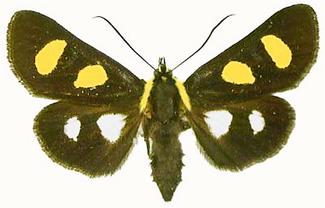
 |


Habitat
Adults: terrestrial
Immatures: terrestrial
Feeding Habits
Adults: nectar and pollen feeding
Immatures: phytophagous
Size: 12 to 170 mm
Flight : strong flier
North American
Species: 2900
|
Lepidoptera Noctuidae
Noctuid moths
Front Wings: scaled
Hind Wings: scaled
Mouthparts: sucking
Antenna Length: shorter than body
Antenna Shape: straight
Front Legs: unmodified
Hind Legs: unmodified
Special Characteristics:
Small to large moths, but most are medium sized (20-45 mm). Most are brown or gray and a few are more colorful and mimic butterflies.Heavy bodied with hairlike antennae, narrow front wings and broad hind wings. Well developed proboscis. The larvae are usually dull colored and smooth, most of them have five pairs of prolegs.
|
|
Comments: Most of the larvae feed on foliage, and some feed on fruits. Some species in this group are serious pests of various crops. The adults feed on nectar, but many species will also feed on fermenting tree sap or decaying fruit. Some species do not feed in the adult stage. The noctuid moths are almost all nocturnal.
|
|
Species:
Alypia octomaculata (Fabricius)
Common Name:
Eight-spotted forester
Feeding Habits: The larvae feed on grapevines and virginia creeper.
Distribution:
Southeastern Canada.
Comments:
The caterpillars are black with orange stripes and have a black-spotted orange head. This species is common in woodland edges, cities and vineyards. The caterpillar will sometimes defoliate grapevines. Adults are active during the day and are often mistaken for butterflies.
|

|